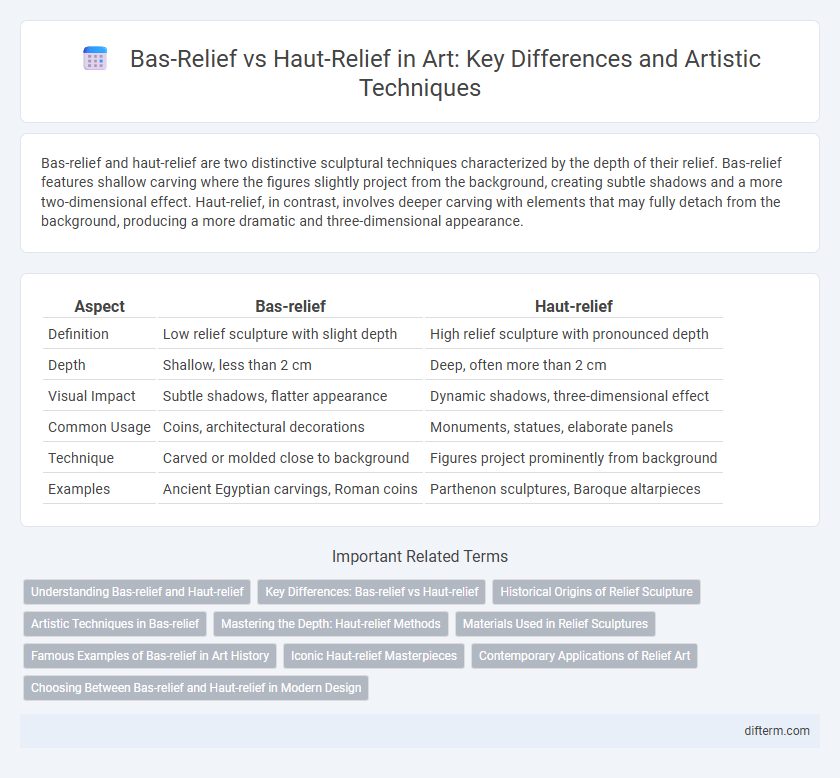Bas-relief and haut-relief are two distinctive sculptural techniques characterized by the depth of their relief. Bas-relief features shallow carving where the figures slightly project from the background, creating subtle shadows and a more two-dimensional effect. Haut-relief, in contrast, involves deeper carving with elements that may fully detach from the background, producing a more dramatic and three-dimensional appearance.
Table of Comparison
| Aspect | Bas-relief | Haut-relief |
|---|---|---|
| Definition | Low relief sculpture with slight depth | High relief sculpture with pronounced depth |
| Depth | Shallow, less than 2 cm | Deep, often more than 2 cm |
| Visual Impact | Subtle shadows, flatter appearance | Dynamic shadows, three-dimensional effect |
| Common Usage | Coins, architectural decorations | Monuments, statues, elaborate panels |
| Technique | Carved or molded close to background | Figures project prominently from background |
| Examples | Ancient Egyptian carvings, Roman coins | Parthenon sculptures, Baroque altarpieces |
Understanding Bas-relief and Haut-relief
Bas-relief, or low relief, features shallow depth where the sculpted elements slightly project from the background, creating subtle shadows and nuanced texture. Haut-relief, or high relief, exhibits a more pronounced three-dimensional quality with figures that significantly extend from the background, often by more than half their depth, providing dramatic visual impact. Understanding the differences between bas-relief and haut-relief is essential for analyzing artistic techniques and the intensity of spatial engagement in sculptural works.
Key Differences: Bas-relief vs Haut-relief
Bas-relief features shallow carving where figures slightly project from the background, preserving most of the surface plane, while haut-relief exhibits deeper carving with figures significantly raised, often appearing nearly three-dimensional. In bas-relief, the depth rarely exceeds half the thickness of the background, creating subtle shadows and a flatter visual impact; haut-relief allows for greater dimensionality and pronounced depth with dramatic shadow effects. Materials commonly used for both include stone, wood, and metal, but the choice influences the level of detail achievable in each relief type.
Historical Origins of Relief Sculpture
Bas-relief and haut-relief both trace their origins to ancient civilizations where sculptors pioneered techniques to create depth on flat surfaces. Bas-relief, characterized by shallow carving, was prominent in Mesopotamian and Egyptian art, enabling intricate narrative friezes on temple walls and monuments. Haut-relief, marked by deeper carving with figures projecting significantly from the background, gained prominence in Greek and Roman art, enhancing dynamic storytelling with more pronounced three-dimensional effects.
Artistic Techniques in Bas-relief
Bas-relief is a sculptural technique where the figures slightly project from the background, creating a shallow depth that emphasizes intricate surface detail without full three-dimensional form. Artists use precise carving and subtle gradations to convey texture, light, and shadow, enhancing narrative storytelling through layered visual elements. This technique contrasts with haut-relief, which involves deeper carving and more pronounced three-dimensionality.
Mastering the Depth: Haut-relief Methods
Haut-relief techniques involve sculpting elements that project significantly from the background, often by more than half their depth, creating pronounced shadows and a dynamic three-dimensional effect. Mastering this method requires precise control over depth gradation and anatomical accuracy to enhance dramatic visual impact while maintaining structural stability. Artists often employ layering and undercutting to achieve the intense relief depth characteristic of haut-relief, distinguishing it from the more shallow bas-relief style.
Materials Used in Relief Sculptures
Bas-relief sculptures commonly use materials like marble, limestone, and bronze that allow for shallow carving and detailed surface texture, suitable for architectural decoration and coins. Haut-relief demands sturdier materials such as granite, sandstone, or wood, which can support deeper carving and more pronounced three-dimensional effects used in monumental and narrative art. Mastery in selecting materials directly impacts the durability and visual impact of relief sculptures in both bas-relief and haut-relief techniques.
Famous Examples of Bas-relief in Art History
Bas-relief, characterized by shallow carving that creates subtle depth, is exemplified by the intricate friezes on the Parthenon in Athens, showcasing classical Greek artistry. The elaborate bas-relief panels of the Angkor Wat temple complex in Cambodia depict detailed mythological narratives and religious iconography. Another iconic example is the Roman Trajan's Column, whose spiral bas-relief vividly records Emperor Trajan's military campaigns with remarkable historical precision.
Iconic Haut-relief Masterpieces
Haut-relief sculptures project significantly from the background, creating a pronounced three-dimensional effect that enhances the dramatic impact of iconic masterpieces like the Parthenon frieze and Donatello's "Saint George." Unlike bas-relief, which features shallow carving, haut-relief allows for deeper modeling and more intricate details, offering a vivid sense of depth and movement. These masterpieces exemplify how haut-relief techniques emphasize narrative complexity and emotional intensity through their elevated sculptural forms.
Contemporary Applications of Relief Art
Bas-relief and haut-relief techniques are extensively utilized in contemporary architectural facades and public sculptures to create dynamic visual narratives that engage viewers through depth and shadow interplay. Bas-relief's shallow depth allows for detailed storytelling on limited surfaces, making it ideal for urban murals and decorative panels, while haut-relief offers pronounced three-dimensional effects suited for immersive installations and interactive art pieces. Advances in digital sculpting and CNC milling have further expanded the possibilities of both relief styles, enabling precise renderings in materials such as metal, stone, and synthetic composites for modern art and design projects.
Choosing Between Bas-relief and Haut-relief in Modern Design
Choosing between bas-relief and haut-relief in modern design depends on the desired depth and visual impact; bas-relief offers subtle, low-depth carving suitable for intricate detailing on flat surfaces, while haut-relief features pronounced, high-relief elements that create dramatic shadows and three-dimensional presence. Material selection and lighting conditions also influence the choice, as bas-relief performs well in tight spaces and under diffuse lighting, whereas haut-relief benefits from directional lighting that enhances its bold contours. Contemporary artists and designers weigh these factors to balance aesthetic appeal with spatial constraints and functional requirements.
Bas-relief vs Haut-relief Infographic

 difterm.com
difterm.com